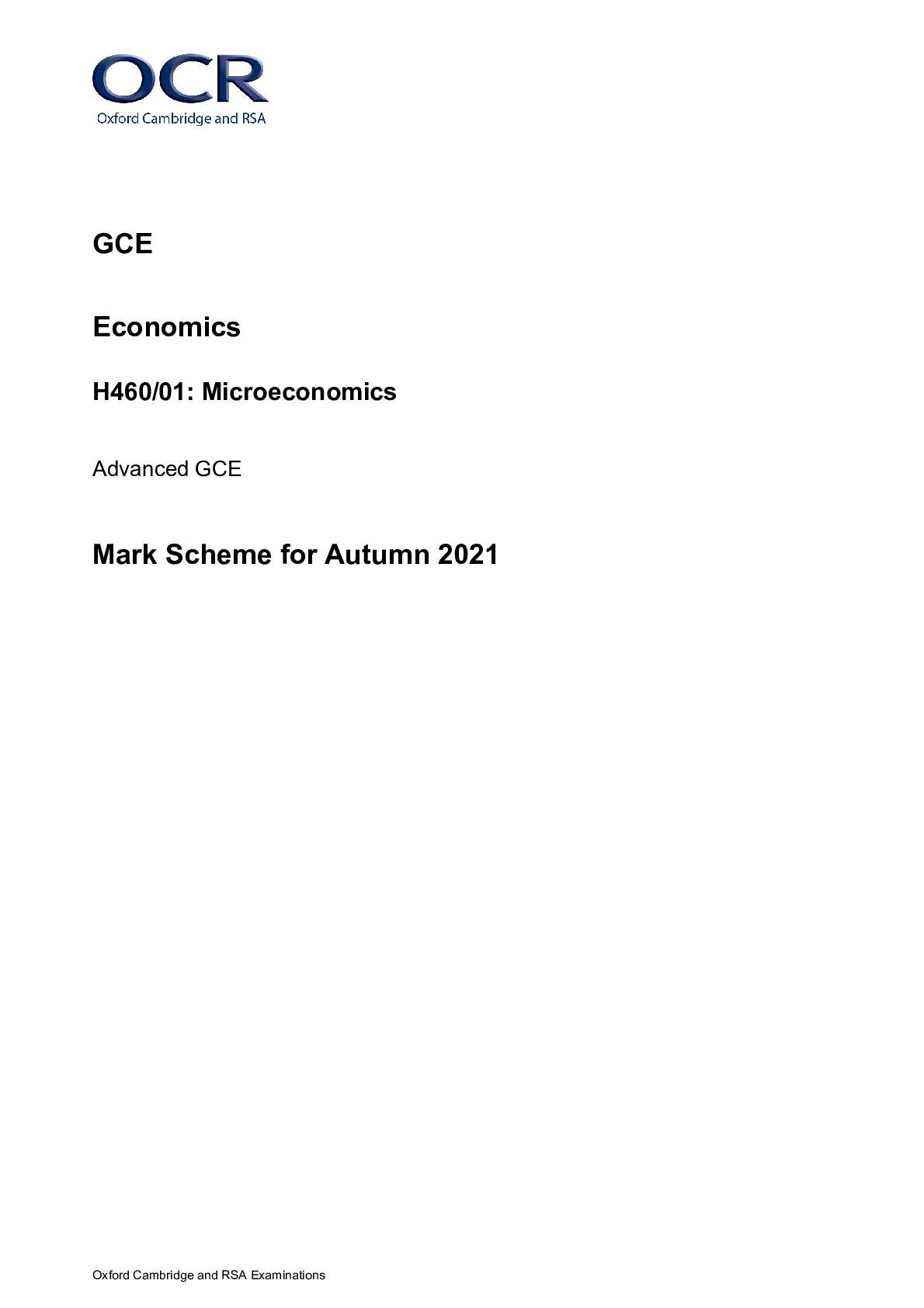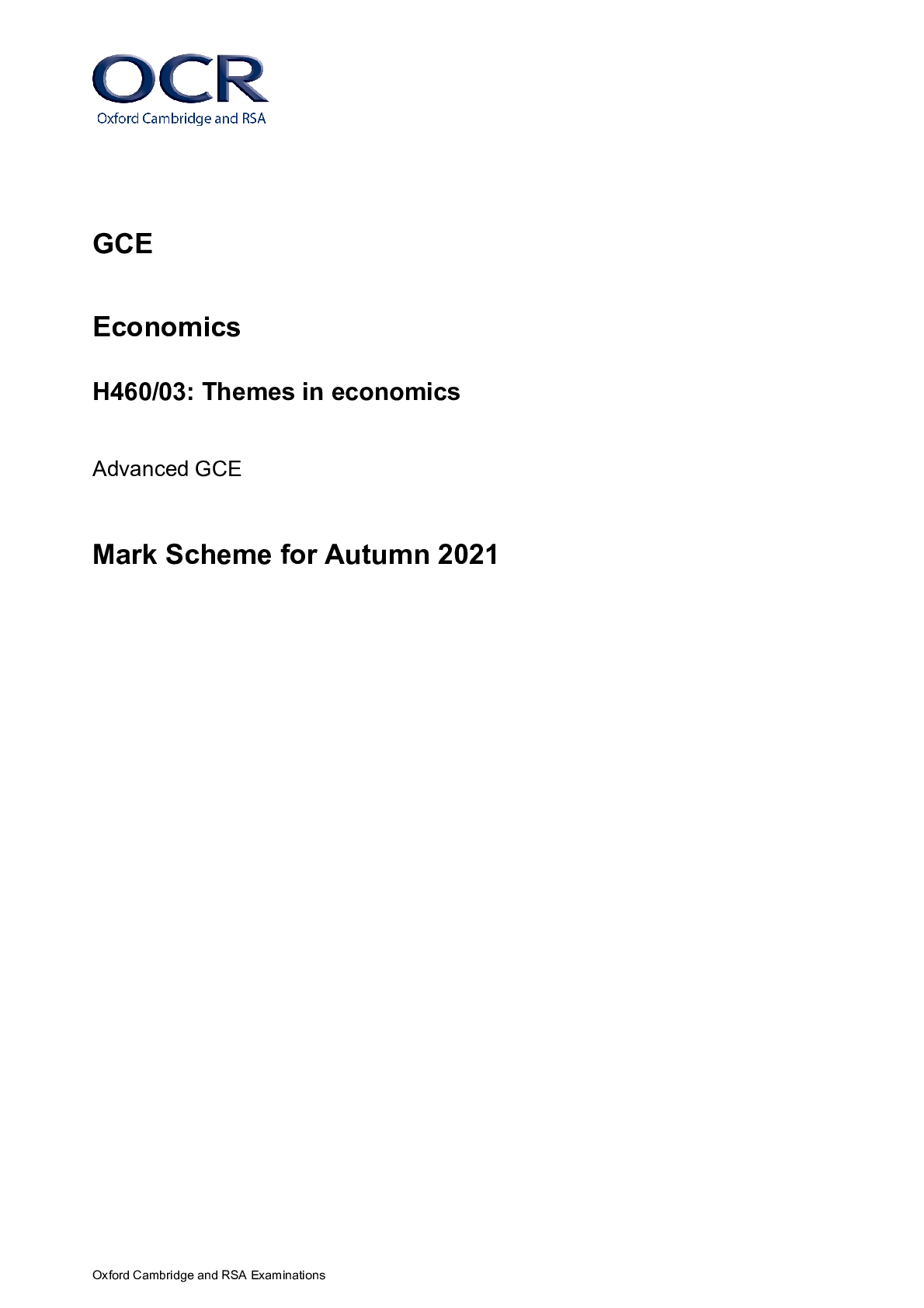Philosophy > MARK SCHEME > GCE Psychology H167/02: Psychological themes through core studies Advanced Subsidiary GCE Mark Schem (All)
GCE Psychology H167/02: Psychological themes through core studies Advanced Subsidiary GCE Mark Scheme for November 2020
Document Content and Description Below
GCE Psychology H167/02: Psychological themes through core studies Advanced Subsidiary GCE Mark Scheme for November 2020 Oxford Cambridge and RSA Examinations GCE Psychology H167/02: Psycholo... gical themes through core studies Advanced Subsidiary GCE Mark Scheme for November 2020Oxford Cambridge and RSA Examinations OCR (Oxford Cambridge and RSA) is a leading UK awarding body, providing a wide range of qualifications to meet the needs of candidates of all ages and abilities. OCR qualifications include AS/A Levels, Diplomas, GCSEs, Cambridge Nationals, Cambridge Technicals, Functional Skills, Key Skills, Entry Level qualifications, NVQs and vocational qualifications in areas such as IT, business, languages, teaching/training, administration and secretarial skills. It is also responsible for developing new specifications to meet national requirements and the needs of students and teachers. OCR is a not-for-profit organisation; any surplus made is invested back into the establishment to help towards the development of qualifications and support, which keep pace with the changing needs of today’s society. This mark scheme is published as an aid to teachers and students, to indicate the requirements of the examination. It shows the basis on which marks were awarded by examiners. It does not indicate the details of the discussions which took place at an examiners’ meeting before marking commenced. All examiners are instructed that alternative correct answers and unexpected approaches in candidates’ scripts must be given marks that fairly reflect the relevant knowledge and skills demonstrated. Mark schemes should be read in conjunction with the published question papers and the report on the examination. © OCR 2020H167/02 Mark Scheme November 2020 Annotations Annotation Meaning Unclear Attempts evaluation Benefit of doubt Context Cross Evaluation Extendable horizontal line Extendable horizontal wavy line Significant amount of material which doesn’t answer the question Not answered question Good use of resources Tick Development of point Omission markH167/02 Mark Scheme November 2020 Question Answer Mark Guidance 1 (a) Explain how the procedure from Bocchiaro et al.’s study relates to the key theme of responses to people in authority. Possible answers: Participants were tested to see if they would obey, disobey or whistleblow (1) a request from a person posing as an experimenter, deemed to be a legitimate authority figure (1), who wanted to carry out a potentially unethical study (into sensory deprivation) (1). The presence of the formally dressed, stern researcher who was deemed by participants to be a legitimate authority figure (1) led to 76.5% of them obeying his unjust/unethical request (1) by writing a statement to convince other students to participate in a sensorydeprivation study (1). Other appropriate answer. 4 3 marks for a clear answer which; • recognises the response is related to obedience/disobedience/whistleblowing • the person in authority is the experimenter/there is an authority figure • outlines how participants’ obedience/disobedience/whistleblowing was investigated i.e. what the participants were asked to do. 2 marks for an answer which addresses at least two of the above points. 1 mark for a partial or vague answer which addresses at least one of the above points; for a partial answer that is not contextualised to Bocchiaro et al.’s study. 0 marks – no creditworthy response. 1 (b) Outline one weakness of the method used in Milgram’s study into obedience. As Milgram’s study is now generally considered a controlled observation containing elements of the experimental condition, possible weaknesses are likely to apply to lack of external validity, artificiality of task/setting, low construct validity, potential for demand characteristics. Examples of 1-mark answer: 2 2 marks for a clearly identified and relevant weakness which is appropriately applied to the study i.e. contextualised. 1 mark for a partial or vague response, not contextualised to Milgram’s study; identifying a relevant ethical weakness either explicitly or implicitly through application to the study (as this is not an actual weakness of the method, it is a weakness of how the method was used). 0 marks – no creditworthy response.H167/02 Mark Scheme November 2020 The method lacks ecological validity (1). The study was unethical because participants showed signs of extreme stress when asked to administer, what they believed were genuine electric shocks to another person (1). Examples of 2-mark answers: The method lacked ecological validity (1) as sitting in a room giving what are presumed to be genuine electric shocks to another person for getting a question wrong does not reflect a rea- life situation (1). The method lacked external validity (1) because people are rarely expected to electrocute a complete stranger (just because they get a question wrong) as measure of obedience (1). Experiments have low construct validity (1) as the dependent variable – in this case, the voltage to which participants shocked – is a very narrow measure of obedience (1). Other appropriate answer. 2 (a) (i) Name the experimental design used in Loftus & Palmer’s study into eye witness testimony. Answer: Independent measures/independent groups. 1 1 mark for correctly naming the design. 0 marks – no creditworthy response e.g. independent. 2 (b) (ii) Outline one weakness of the way the sample was organised in Loftus and Palmer’s first experiment. 2 2 marks for a clearly identified and relevant weakness of the way the sample was organised which is appropriately applied to the study i.e. contextualised.H167/02 Mark Scheme November 2020 Examples of a 1-mark answer: The way the sample was organised mean the results could lack validity because different participants were used in each condition so individual differences may have affected the results (1). (No context) Different participants were used in each condition so individual differences may have affected results (1). (No context) Examples of 2-mark answers: The results may lack validity because different participants were used in each of the conditions - (smashed, collided, hit, contacted and bumped (1) - so individual differences may have affected the results (1). Different participants were used in the five speed conditions so one may not be comparing participants with the same driving experiences (1) which could have influenced their ability to estimate speed (and therefore the validity of the results) (1). Other appropriate answer – must refer to the way the sample was organised. 1 mark for identifying a relevant weakness of how the sample was organised, not contextualised to the study. 0 marks – no creditworthy response e.g. any references to possible weaknesses of either the sample or how it was gathered. 3 (a) To what extent does Chaney et al.’s Funhaler study change our understanding of the key theme of external influences on children’s behaviour? Support your answer with evidence from appropriate core studies. Example of a 1-mark answer Chaney’s study showed that children can learn through positive reinforcement whereas Bandura showed that 3 3 marks for a clear and accurate response which demonstrates knowledge and understanding of how Chaney et al.’s study changes/adds to our understanding of the key theme. To get the full 3 marks there needs to be a clear comparison to show how understanding has changed/developed. 1-2 marks for a brief or vague response which shows some knowledge and understanding of Chaney et al.’s study and makes some attempt to show how this studyH167/02 Mark Scheme November 2020 children can learn observing behaviours demonstrated by significant others (1). (No context) Example of a 2-mark answer Chaney’s study showed that children who used a funhaler learnt through positive reinforcement/operant conditioning (1) whereas Badura had previously shown that children can learn behaviour through observing role models (1). Example of a 3-mark answer There are other external influences on children’s behaviour beyond observing the behaviour of role models/significant others as found in the earlier study by Bandura et al (1]). Grant’s study showed that children can learn through the process of operant conditioning/positive reinforcement (1) as when the participants used the funhaler there was a positive effect on their asthmatic conditions making them more willing to adhere to their medical regime, thus improving their health status (1). Other appropriate answer. changed understanding of the key theme. Only 1 mark can be awarded if the answer /a merely description of Chaney et al.’s study is not contextualised. 0 marks – no creditworthy response. 3 (b) Describe one similarity between Chaney et al.’s study and Bandura et al.’s study into the external influences on the development of children’s behaviour. Possible similarities: • Experimental method • Children as participants • Both used boys and girls • Use of quantitative data • Based on behaviourist principles 4 4 marks – for a clear response which; • identifies a similarity • further outlines that similarity • illustrates the similarity with reference to Chaney et al.’s study • illustrates the similarity with reference to Bandura et al.’s study. 3 marks for a vague response with the all of the above points or for a clear response with three of the points. 2 marks for a vague response with three of the above points or for a clear response with two of the points.H167/02 Mark Scheme November 2020 • Both used fun/interesting toys as incentives. Examples of 4-mark answer: Both studies employed the experimental method (1) by manipulating an IV (1). In the Chaney et al. study the IV was whether a child was using a standard inhaler or a funhaler (1) while in the Bandura et al. study one of the IVs was whether a model behaved aggressively or not (1). Both studies use children as participants (1). This means one can study the development of behaviour as individuals grow and mature (1). Bandura et al. used children aged 37-69 months (1) and Chaney et al. used children aged 1.5 – 6 years of age (1). Other appropriate answer. 1 mark for a vague response with two of the above points or for a clear response with the difference identified/implied. 0 marks – no creditworthy response. 4 (a) (i) Give the sample used in Sperry’s split-brain study. Possible answers: • 11 participants/patients • Participants/patients who had undergone brain surgery • A small sample who had split-brain undergone brain surgery/a commissurotomy to control epilepsy. Other appropriate answer. 1 1 mark for correctly identifying at least one appropriate feature of the sample e.g. ‘patients’, ‘undergone brain surgery’. Accept small sample rather than actual number. 0 marks – no creditworthy response 4 (a) (ii) Outline one example of sampling bias in this study. Possible answers: • Had to have had brain surgery (so leads to a small sample) (1) – difficult to generalise (1) 3 2 marks for identifying a bias in the sample and for explaining its impact in the context of this study. 1 mark for identifying a bias in the sample with no explanation of its possible impactor for a muddled explanation/not contextualised.H167/02 Mark Scheme November 2020 • All had experienced epilepsy (1) which may have confounded the results of the study (1) Examples of a 1-mark answer: The sample was small because all participants had had commissurotomies. All participants suffered from severe epilepsy. Examples of a 2-mark answer: The sample was small because all participants had had commissurotomies (1). It is therefore very difficult to generalise the findings (1). All participants suffered from severe epilepsy which may have influenced their brain function beyond the effects of the surgery (1), thus confounding the results (1). Other appropriate answer. 0 marks – no creditworthy response e.g. there were more men/women than women/men, it was androcenric – the study only identified that of the 11 participants, there was one woman and one man. 4 (b) Describe the background to Casey et al.’s study of neural correlates in the delay of gratification. Most likely content: • Previous research showed performance on a delay-of-gratification task in childhood predicted the efficiency with which the same individuals performed a cognitive control task (go/no go task) as adolescents and young adults (1-2). Casey et al. wanted to build on previous research to assess whether delay of gratification in childhood predicts impulse control abilities in adulthood (1-2). 4 3-4 marks for a detailed and accurate description of the background to the study that demonstrates sound knowledge and understanding of the subsequent aim of the investigation. 1-2 marks for a brief or vague description of the background to the study which may contain some inaccuracies or irrelevancies. 0 marks – no creditworthy response. NB: If the candidate merely refers to Casey et al.’s aim without any reference to the background, only 1 mark can be awarded.H167/02 Mark Scheme November 2020 • Previous research had shown that those who as pre-schoolers directed their attention toward rewarding aspects of the classic delay-ofgratification situation, such as focusing on cookies (high-temptation-focus group) had more difficulty suppressing inappropriate actions than did their low-temptation-focus counterparts (1-2). Casey et al. wanted to build on this research to find out if there were regions of the brain that correlated with low self-control and diminished ability to defer gratification (1-2). • The findings suggested that performance in preschool delay of gratification may predict the capacity, in adulthood, to control thoughts and actions, as reflected in performance on cognitive control tasks (1-2). Casey et al. wanted to build on this to find out if there were regions of the brain that correlated with low self-control and diminished ability to defer gratification (1-2). • Research has shown that alluring or social contexts can diminish self-control (1-2). Casey et al. wanted to build on this research to find out if there were regions of the brain that correlated with low selfcontrol and diminished ability to defer gratification (1-2). Answers may also refer to: • The ability to control one’s thoughts and actions can vary by the potency of interfering information. • A correlation has been found between an avoidance of risky behaviour and greater excitation in the right inferior frontal gyrus. It has been found that the ventral striatum facilitates and balances motivation with both higher-level and lower-levelH167/02 Mark Scheme November 2020 functions, such as inhibiting one’s behaviour in a complex social interaction. • This region has been found to be the region in the basal ganglia neural circuit most closely associated with reward. Other appropriate answer.H167/02 Mark Scheme November 2020 Question Answer Mark Guidance 5 Explain one way in which Freud’s study of Little Hans could be criticised for its lack of reliability. Possible content: • use of case study method • use of secondary data • many ideas open to interpretation • unrepresentative sample Example of a 1-mark answer: The use of the case study method produces unreliable findings as it cannot be replicated (1). (No context) Example of a 2-mark answer: Freud only studied Little Hans so his sample was unrepresentative (1) making the study unreliable (1). Example of a 3-mark answer: The case study method is unreliable as it not replicable (1) as we only have Freud’s account and interpretation of Little Hans’ experiences at the time (1) and it would be difficult for someone else to revisit this after the event to assess for reliability (1). Freud investigated Little Hans’ fears and fantasies using the case study method which lacks reliability as it does not have a standardised procedure (1). The way in which Hans was observed and questioned by his father was not standardised as the situation was unique to Hans (1). The procedure cannot therefore be replicated to assess whether other boys experience the Oedipus complex/go through the five psychosexual stages of development (1). 3 3 marks for a clearly described issue associated with reliability which is well developed in the context of the study. 2 marks for a reasonably described and relevant issue associated with reliability loosely or vaguely linked to Freud’s study 1 mark for the mere identification of a relevant issue which is not in the context of the study. 0 marks – no creditworthy response.H167/02 Mark Scheme November 2020 Other appropriate answer. 6 (a) Outline two defining principles and concepts of the cognitive area. Possible content: • Internal mental processes such as memory, thinking and reasoning that precede observable behaviour • The approach uses experimental methods to infer thoughts by recording individual’s behaviour in cognitive tasks • The mind is seen as mechanistic suggesting that we process information like a computer which inputs, processes and outputs information • Behaviour is highly predictable based on patterns in thinking • Thought patterns can be changed • Human behaviour can be explained as a set of scientific principles • Behaviour is controlled by our own thought processes as opposed to genetic factors • Mental processes guide behaviour • If individuals receive, process and respond to information in different ways, their behaviour will be different Other appropriate principles/concepts. 4 For each defining principle/concept. 2 marks for a clear and accurate outline. 1 mark for a brief or vague outline. 0 marks – no creditworthy response. 6 (b) One strength of the cognitive area is that it favours the scientific method. Explain why this is a strength. Support your answer with evidence from an appropriate core study. Possible answers: • This allows for cause and effect to be established (1) so one can establish if an individual factor 3 3 marks for a clearly described, well developed and relevant strength that is related to the cognitive area (not specific studies). This may be illustrated through appropriate evidence. 2 marks for a reasonably well described and relevant strength that is related to the cognitive area (not specific studies). This may be illustrated through weak, but appropriate evidence.H167/02 Mark Scheme November 2020 affects behaviour (1]) For example, Loftus and Palmer were able to establish that the different speed estimates were caused by the different verbs used in the critical question (1). • It allows for replicability (1) which can increase reliability if consistent results occur (1), supported by appropriate evidence from either Loftus and Palmer’s or Grant et al.’s studies (1). • This increases objectivity (1) which reduces subjectivity and the possibility of the experimenter influencing findings (1), supported by appropriate evidence from either Loftus and Palmer’s or Grant et al.’s studies (1). • It allows quantitative data to be collected (1]) which allows for comparisons to be made between individuals or groups (1). For example, the speed estimates given by the participants in the five groups could be compared to see the influence of the different verbs (smashed, collided, hit contacted, bumped) on participants’ memories. Other appropriate answer. 1 mark for a briefly stated strength or one that is muddled/not contextualised. 0 marks – no creditworthy response. N.B. If studies not listed under the cognitive area for this specification are used as evidence, the candidate must have made it clear why they can be considered cognitive studies. 6 (c) One weakness of the cognitive area is that studies can lack ecological validity. Explain why this is a weakness. Support your answer with evidence from an appropriate core study. Answers could refer to: • An understanding that lacking ecological validity infers that the study and its results are unlikely to represent real-life situations (1). Supported by appropriate evidence from either Loftus and Palmer’s or Grant et al.’s studies (1). • An explanation as to why studies in the cognitive area can lack ecological validity, e.g. many studies are laboratory experiments, conducted in controlled, unrealistic conditions (1). Supported by appropriate 3 3 marks for a clearly described, well developed and relevant weakness that is related to the cognitive area (not specific studies). This may be illustrated through appropriate evidence. 2 marks for a reasonable well described and relevant weakness that is related to the cognitive area (not specific studies). This may be illustrated through weak, but appropriate evidence. 1 mark for a briefly stated weakness or one that is muddled/not supported by appropriate evidence. 0 marks – no creditworthy response.H167/02 Mark Scheme November 2020 evidence from either Loftus and Palmer’s or Grant et al.’s studies (1). Other appropriate answer. N.B. If studies not listed under the cognitive area for this specification are used as evidence, the candidate must have made it clear why they can be considered cognitive studies. 6 (d) Explain how Grant et al.’s study into contextdependent memory can be considered useful. Answers could refer to: • The concept that if an individual is asked to recall information in the same situation as it was first received, their memory can be enhanced and this is useful as it leads to individuals remembering information more accurately (1). Grant et al.’s study showed that studying and testing in the same environment can lead to enhanced performance, particularly if the learning and recall are both effected in silent conditions (1]) This could be very useful for both teachers and students who could do their best to learn and study in quiet environments as, when under examination conditions they will be asked to recall what they have learned in silence (1). • The concept that if an individual is asked to recall information in the same situation as it was first received, their memory can be enhanced and this is useful as it leads to individuals remembering information more accurately (1). Grant et al.’s study showed that studying and testing in the same environment lead to enhanced performance (1). This could be useful for the police when asking eyewitnesses to recall information relating to a crime they had witnessed as they can either ask the witness to imagine the crime scene/take them to the crime scene itself as re-establishing the original environment may lead to more accurate recall and evidence statements (1). 3 3 marks for a clear and accurate response which demonstrates both knowledge and understanding of Grant et al.’s study, and how the findings can be useful. 1-2 marks for a brief or vague response which shows some knowledge and understanding of Grant et al.’s study and makes some attempt to show how findings could be useful. No more than 1 mark can be gained if the answer has no contextualisation. 0 marks – no creditworthy response.H167/02 Mark Scheme November 2020 Other appropriate answer. 6 (e) Discuss the nature/nurture debate in psychology. Use examples from relevant core studies to support your answer. Nature: The basic assumption is that behaviour is heredity and linked to biological factor - the characteristics of the human species as a whole are a product of evolution and that individual differences are due to each person’s unique genetic code. Nurture: The basic assumption is that at birth the human mind is a blank slate and that this is gradually “filled” as a result of experience with the environment through direct and indirect learning. Possible strengths of nature argument: • Evidence that certain behaviours appear difficult to change/condition • Evidence from twin studies, adoption studies, etc • Success in genetic engineering Possible weaknesses of nature argument: • Cross cultural differences in behaviours or incidence of behaviours • Too deterministic – biological determinism • Too reductionist – behaviours too complex to be attributed to single genes Possible strengths of nurture argument: • Evidence of behaviour change through conditioning, etc 12 10-12 marks for a thorough and balanced discussion that is relevant to the demands of the question. Arguments are coherently presented with clear understanding of the points raised. A range of points are considered and are well developed as part of the discussion. There is evidence of valid conclusions that summarise issues very well. Relevant evidence is used to good effect to support the points being made. There is consistent use of psychological terminology, and well-developed line of reasoning which is logically structured. Information presented is appropriate and substantiated. 7-9 marks for a good and reasonably balanced discussion that is mainly relevant to the demands of the question. Arguments are presented with reasonably clear understanding of the points raised. A range of points are considered and some are developed as part of the discussion. There is evidence of valid conclusions that summarise issues well. Relevant evidence is used mostly to good effect to support the points being made. There is good use of psychological terminology in a response with reasonable structure. Information presented is largely appropriate. 4-6 marks for a limited discussion that has some relevancy to the demands of the question. Arguments are presented but with limited understanding of the points raised. Two or more points are considered and may be developed as part of the discussion. There is evidence of attempts to draw conclusions. Relevant evidence is used as part of the discussion. There is some use of psychological terminology in a responseH167/02 Mark Scheme November 2020 • Supported by hard scientific evidence of observable behaviours • Investment in strategies to change behaviours e.g. penal system, education system, therapies Possible weaknesses of nurture argument: • Too deterministic – ignores role of free will • Too holistic making it difficult to establish cause and effect • Focus on situation at expense of individual Examples of research supporting nature: • Milgram – shows tendency to obey more about nature than a cultural trait • Loftus & Palmer – reconstruction of memory is part of human nature • Casey et al – brain function affects ability to delay gratification and this may be due to genetic inheritance • Freud – psychosexual stages and complexes are part of human nature • Baron-Cohen et al – evidence that autism is a distinct syndrome and potentially inherited Examples of research supporting nurture: • Milgram – shows the impact of environment (authority) on obedience • Loftus & Palmer – how memories are reconstructed depends on environment e.g. misleading information • Bandura – effect of modelling on aggressive behaviour • Chaney et al – effect of reinforcement on medical compliance • Freud – how a child copes with psychosexual conflicts is dependent on action of parents with limited structure. Information presented is sometimes appropriate. 1-3 marks for a basic discussion that is rarely relevant to the demands of the question. Arguments are presented but with weak understanding of the points raised. One or a limited range of points are considered with no real development. Relevant evidence is weak or not apparent at all. There is limited or no use of psychological terminology and structure is poor. Information presented is rarely appropriate. 0 marks – no creditworthy response. N.B. Even if the candidate raises the required number of points for a particular mark band, this does not automatically place the response in that band. The overall quality of the response and the other requirements for each band must be considered. N.B. Candidates who only describe EITHER the nature OR the nurture side of the debate/describe the nature/nurture debate and illustrate/support each explanation for behaviour with appropriate evidence can gain a maximum of 6 marks: To access the higher marking bands the strengths and/or weaknesses of both sides of the debate need to be considered. N.B. Study-specific answers are not creditworthy as they do not answer the question which asks candidates to discuss the nature/nurture debate. The question does not ask candidates to discuss strengths and weakness of individual studies. However, candidates may introduce a possible strength/weakness of the debate through firstly citing their evidence and then linking this to the debate.H167/02 Mark Scheme November 2020 Other appropriate suggestions and/or appropriate evidence.H167/02 Mark Scheme November 2020 Question Answer Mark Guidance 7 (a) Outline one issue of validity raised by the article. Potential issues: • Validity of cause and effect – does viewing increase obesity or are obese children drawn to these activities or are there extraneous variables, e.g. type of parenting. • Population validity – the sample may not be representative as it relies on people who are online in the first place • Validity of response/data – as the findings rely on accuracy of memory/self-reports which may not reflect the truth • Concurrent ability – the absence of peer review may question the reliability of findings/conclusions. Other appropriate answer. 2 2 marks for identifying a relevant issue and developing it in the context of the article 1 mark for identifying a relevant issue not contextualised to the article. N.B. It is not possible to credit the application mark without the knowledge mark, i.e. identifying a relevant issue, otherwise the candidate is simply quoting from the article with no evidence of understanding. 0 marks – no creditworthy response. 7 (b) (i) Identify the type of data quoted in the article. Answer: Quantitative data 1 1 mark for the correct answer. Accept ‘numerical’. 0 marks – No creditworthy response. 7 (b) (ii) Outline one strength of using this type of data in the research quoted in the article. Possible strengths: • Easy to make comparisons • Objective • Easy to replicate Example of a 1-mark answer: The data is not really open to interpretation. The data is objective. 2 2 marks for a response which identifies a relevant strength which is then developed in the context of the article. 1 mark for identifying a relevant strength of quantitative data not contextualised to the article. 0 marks – no creditworthy response.H167/02 Mark Scheme November 2020 Examples of a 2-mark answer: It is easy to look for patterns (1) to see if there is a relationship between hours spent using the media and how obese someone is (1). It allows comparisons between groups to be made (1), e.g. children who watched more than 3 hours of commercial TV a day were 59% more likely to be overweight or obese than children who watched half an hour a day or less (1). Other appropriate answer. 7 (c) Explain how the behaviourist perspective may be applied to this article. Possible content: • Obese children may be imitating eating behaviours • Role models may be used to promote unhealthy food • Vicarious reinforcement – eating junk food may be seen as rewarding e.g. satisfied, cool, etc. • Children are learning to adopt unhealthy behaviours from their immediate environment Other appropriate answer. 4 4 marks for demonstrating good understanding of the perspective through effective application to the article. 3 marks for demonstrating good understanding of the perspective and for applying it vaguely to the article, or demonstrating a brief understanding of the perspective and effective application to the article. 2 marks for demonstrating a brief understanding of the perspective and for applying it vaguely to the article. 1 mark for demonstrating understanding of the perspective with no contextualisation to the article. N.B. It is not possible to credit the application mark without the knowledge mark, i.e. showing some understanding of the behaviourist perspective, otherwise the candidate is simply quoting from the article with no evidence of understanding. 0 marks – no creditworthy response.H167/02 Mark Scheme November 2020 7 (d) Using your knowledge of psychology, suggest two ways in which children could be encouraged to be more physically active. Possible suggestions: • Use of positive reinforcement (rewards), e.g. medals, certificates, tokens • Vicarious reinforcement, e.g. adverts/websites showing children who are happier/more popular through doing exercise • Modelling, e.g. using popular celebrities and characters to promote physical activity • Establishing social norms, e.g. make physical activity socially desirable • Punishment, e.g. producing materials that show the negative consequences of not exercising • Changing attitudes/schemas, e.g. children see the benefits of exercise as outweighing the costs • Delay of gratification, e.g. internet/TV usage only allowed after physical activity • Use of talking therapy to find out why children are obese and then find ways of encouraging physical activity to reduce the obesity Other appropriate suggestions 8 7-8 marks for a high standard of knowledge and understanding of how the two ways could be used to encourage children to be more physically active. There is very effective application of psychological knowledge within these suggestions. The suggestions are largely accurate and several details have been included about how they could be implemented and developed. 5-6 marks for a good standard of knowledge and understanding of how the two ways could be used to encourage children to be more physically active. There is effective application of psychological knowledge within these suggestions. The suggestions are mostly accurate and some details have been included about how they could be implemented and developed. 3-4 marks for reasonable knowledge and understanding of how the two ways could be used to encourage children to be more physically active. There is some application of psychological knowledge within these suggestions. The suggestions are partially accurate. 1-2 marks for basic knowledge and understanding of how the two ways could be used to encourage children to be more physically active. There is weak application of psychological knowledge within these suggestions. The suggestions may have limited accuracy. 0 marks – No creditworthy response. N.B. If only one suggestion/the same psychological application is used twice, e.g. two examples of how positive reinforcement could be used is made then a maximum of 4 marks to be awarded. Award marks in line with the descriptors above. N.B The suggestions must be feasible.H167/02 Mark Scheme November 2020 7 (e) Evaluate the suggestions you have made in part(c) with reference to issues and debates you have studied in psychology. Potential issues for evaluation: • Assumptions relating to nature/nurture • Assumptions relating to freewill/determinism • Assumptions relating to reductionism/holism • Assumptions relating individual/situational explanations • Usefulness • Ethical considerations • Social sensitivity • Psychology as a science • Ethnocentrism • Validity • Reliability 8 7-8 marks for demonstrating good evaluation that is relevant to the demand of the question. The arguments are coherently presented with clear understanding of the points raised. A range (at least two) of appropriate evaluation points relating to issues and debates are considered. The evaluation points are in context and supported by relevant evidence of the description given in 7d. More than one suggestion is evaluated. 5-6 marks for demonstrating reasonable evaluation that is mainly relevant to the demand of the question. The arguments are coherently presented in the main with reasonable understanding of the points raised. A range (at least two) of appropriate evaluation points relating to issues and debates are considered. The evaluation points are mainly in context and supported by relevant evidence of the description given in 7d. More than one suggestion is evaluated. 3-4 marks for demonstrating limited evaluation (at least one point) that is sometimes relevant to the demand of the question. The arguments may lack clear structure/organisation and show limited understanding of the points raised in relation to issues and debates. The candidate may evaluate only one suggestion. The evaluation points are occasionally in context and supported by relevant evidence of the description given in 7d. 1-2 marks for demonstrating basic evaluation (one weak point) that is rarely relevant to the demand of the question. Any arguments lack clear structure/organisation and show a very basic understanding of the points raised in relation to issues and debates. Only one suggestion is likely to be evaluated. The evaluation points are not necessarily in context and are not supported by relevant evidence of the description given in 7d.H167/02 Mark Scheme November 2020 0 marks – No creditworthy response. N.B. If only one suggestion is evaluated then a maximum of 4 marks to be awarded. Award marks in line with the descriptors above. If the candidate merely evaluates their 7(c) suggestions without making any reference to issues and debates no marks can be awarded. Any issues and debates must be clearly identified to gain credit. N.B. Even if the candidate raises the required number of points for a particular mark band, this does not automatically place the response in that band. The overall quality of the response and the other requirements for each band must be considered.OCR (Oxford Cambridge and RSA Examinations) The Triangle Building Shaftesbury Road Cambridge CB2 8EA [Show More]
Last updated: 1 year ago
Preview 1 out of 24 pages
Instant download

Buy this document to get the full access instantly
Instant Download Access after purchase
Add to cartInstant download
Reviews( 0 )
Document information
Connected school, study & course
About the document
Uploaded On
Oct 07, 2022
Number of pages
24
Written in
Additional information
This document has been written for:
Uploaded
Oct 07, 2022
Downloads
0
Views
54


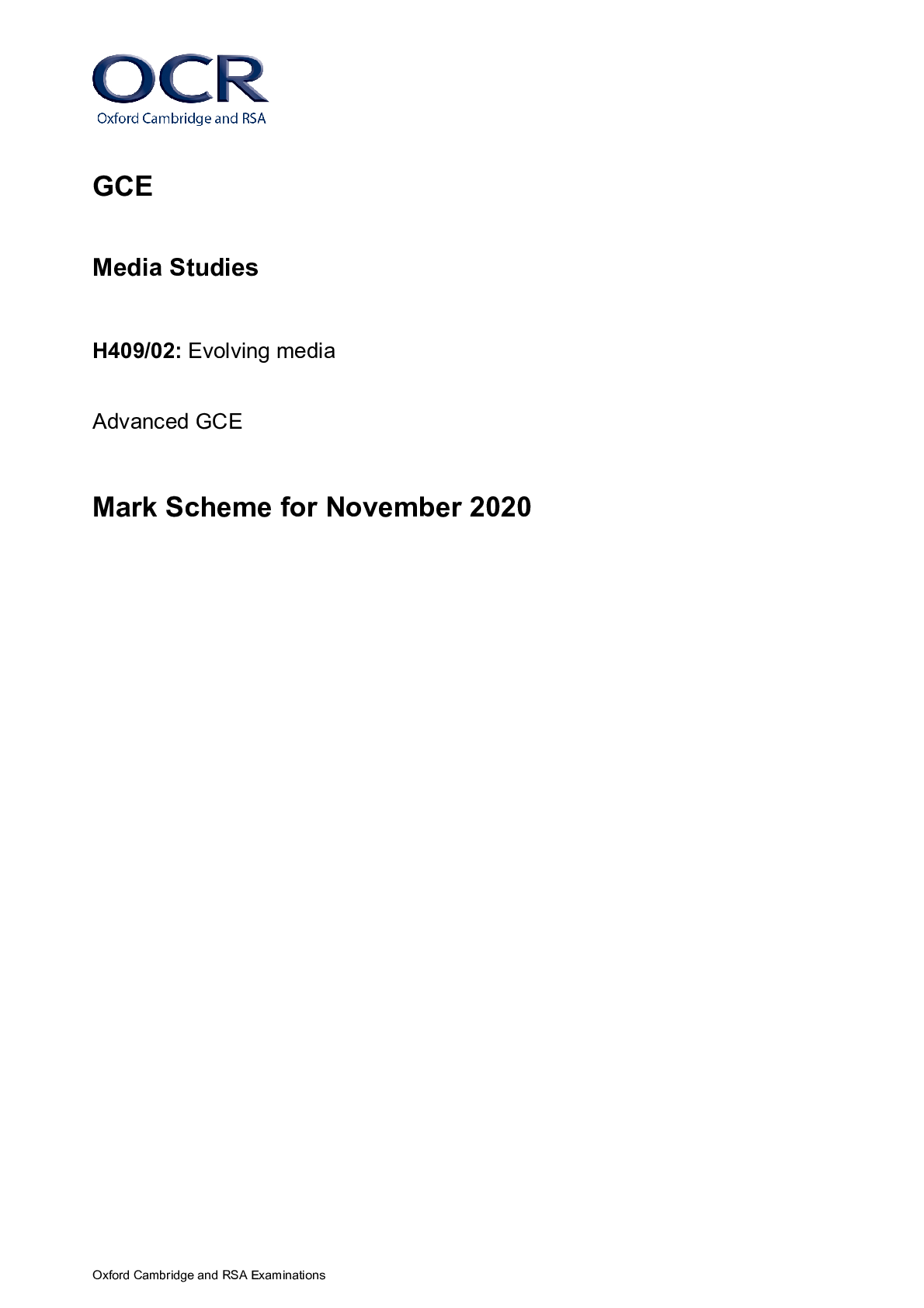
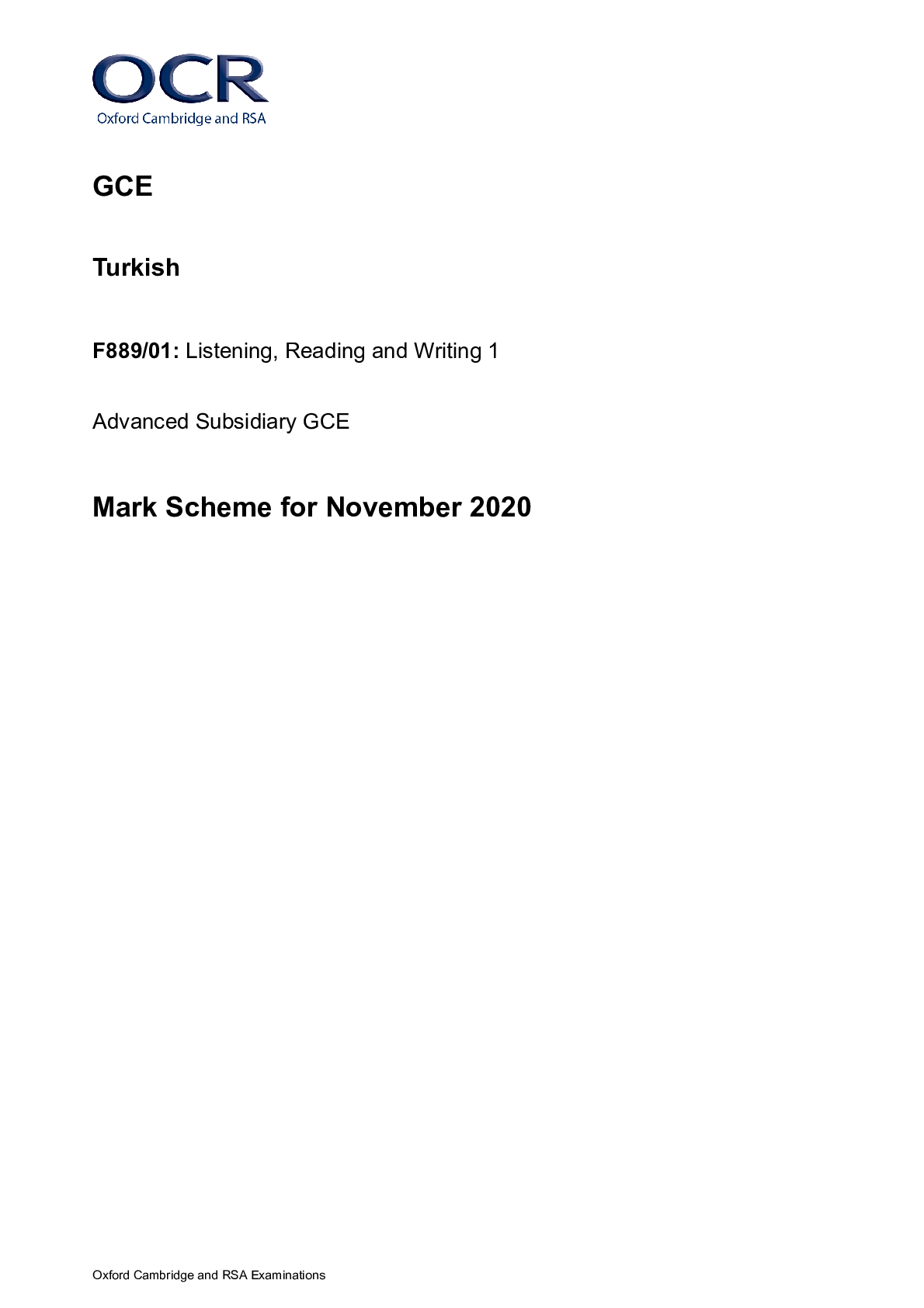
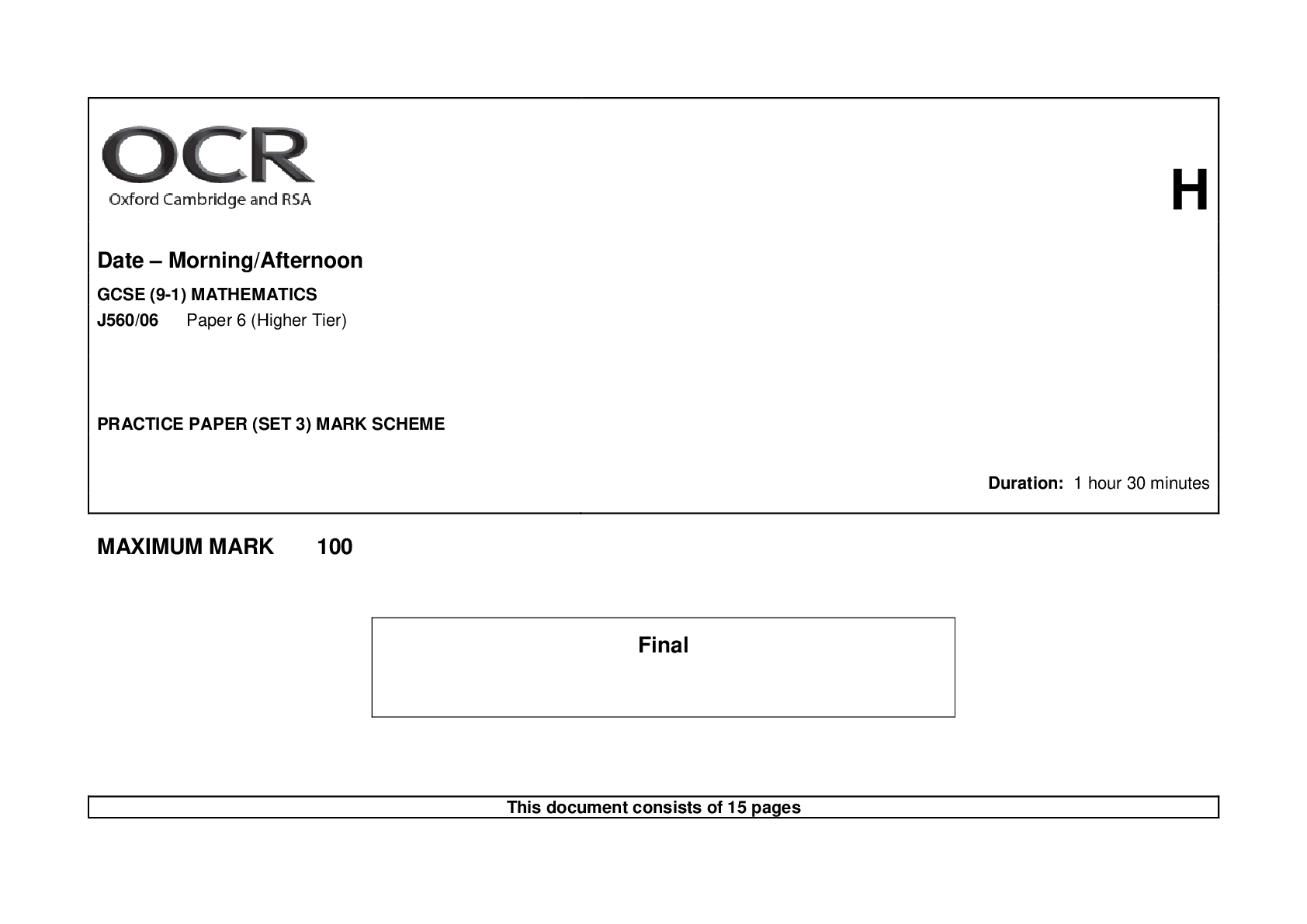


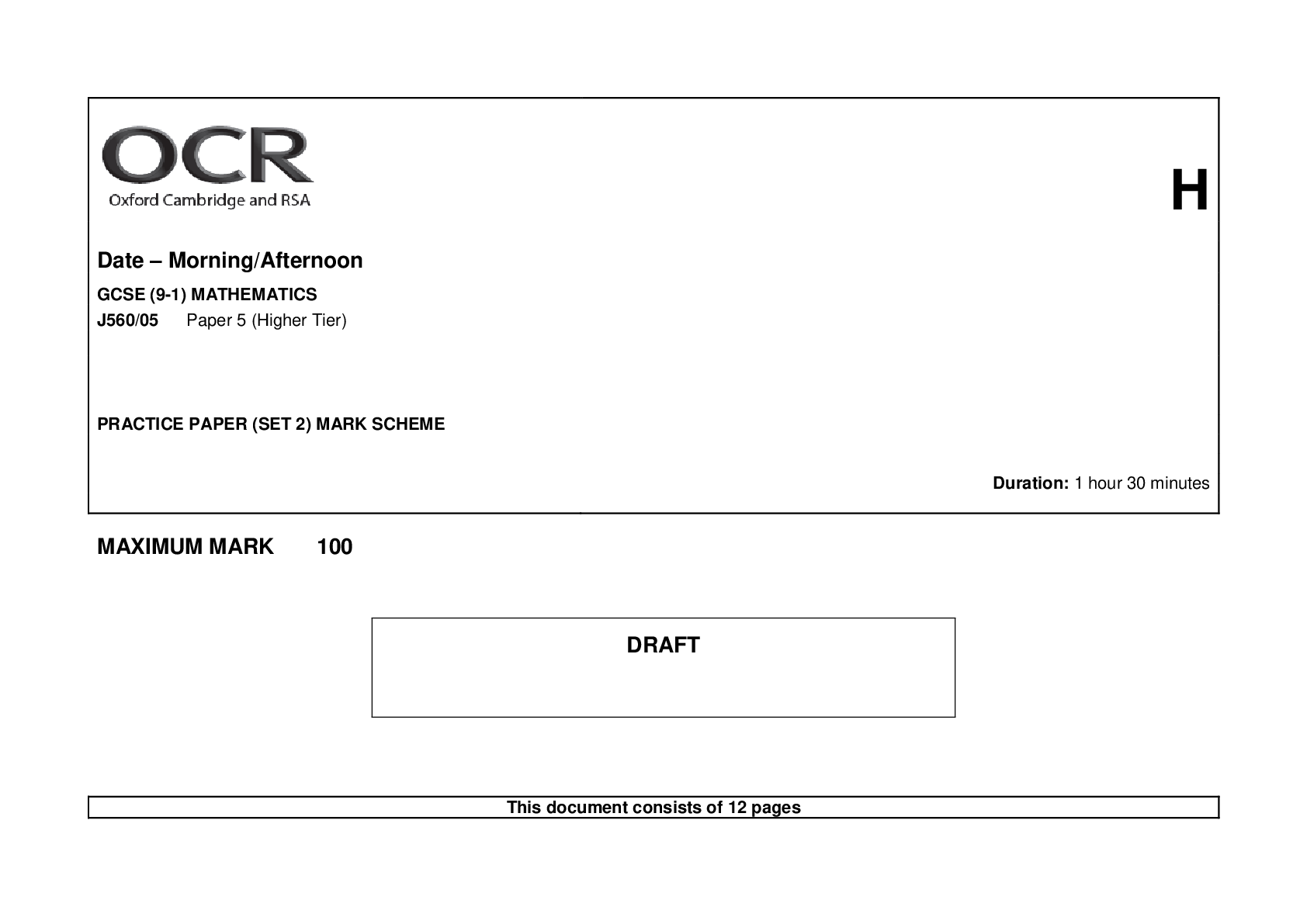
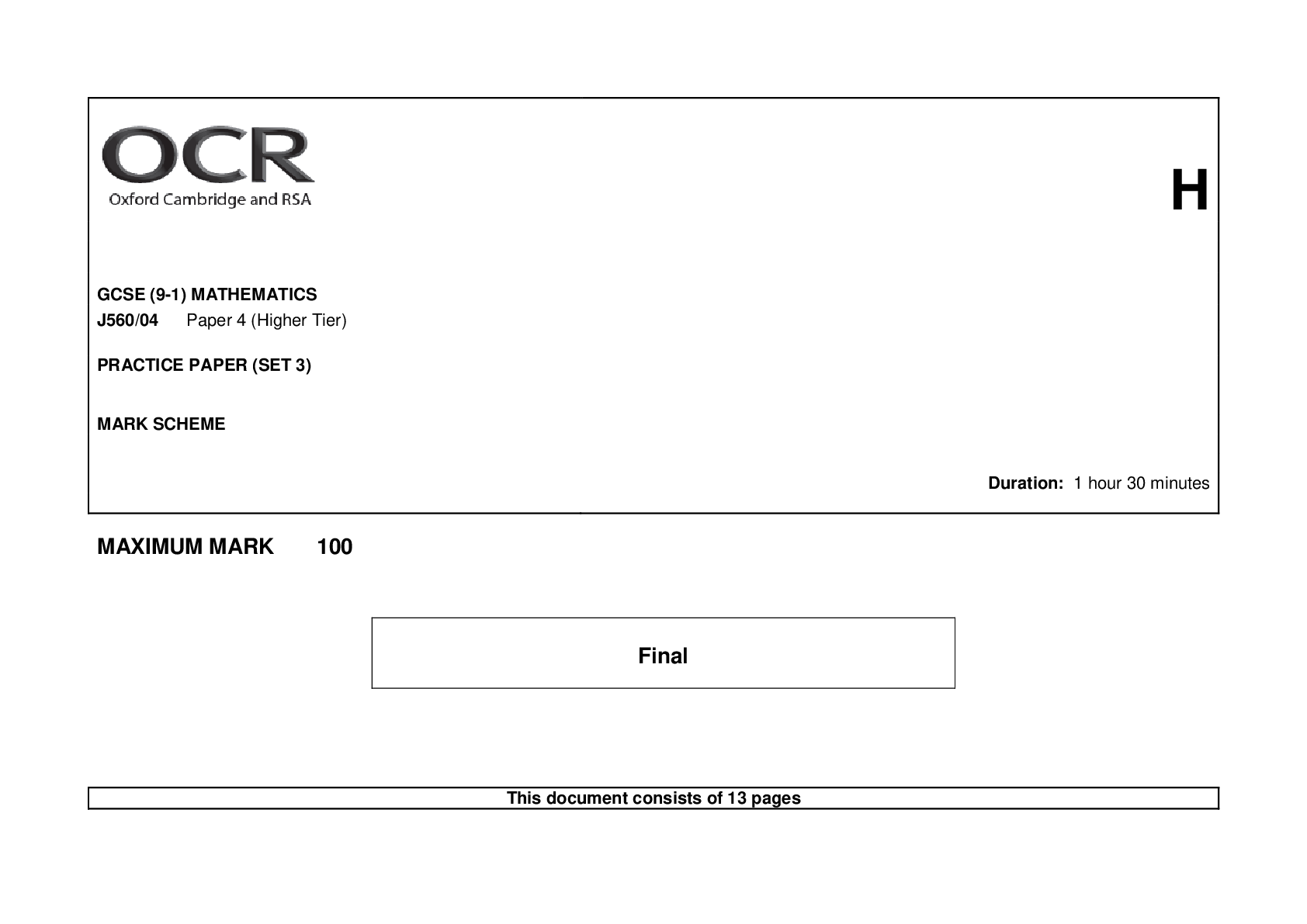



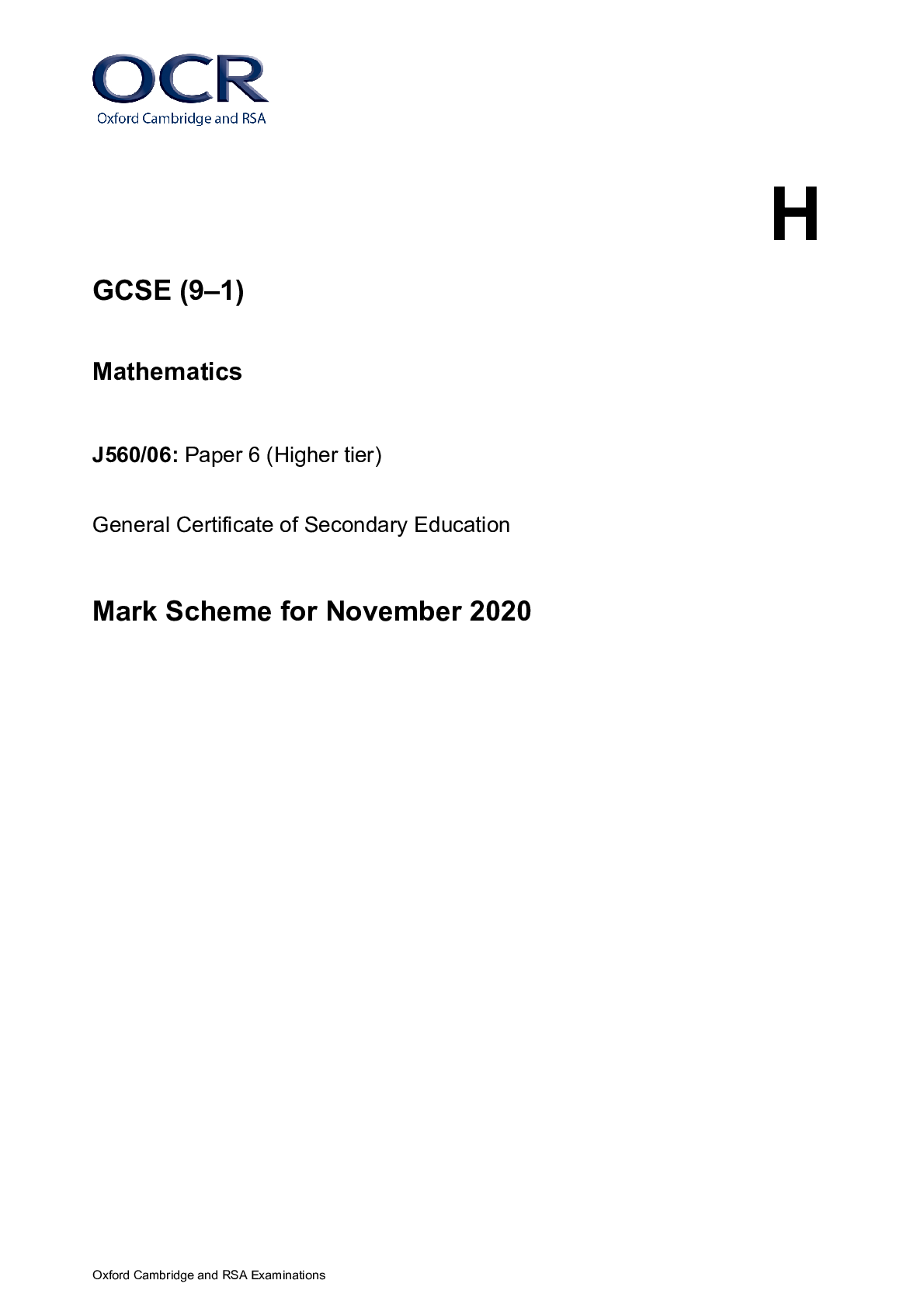
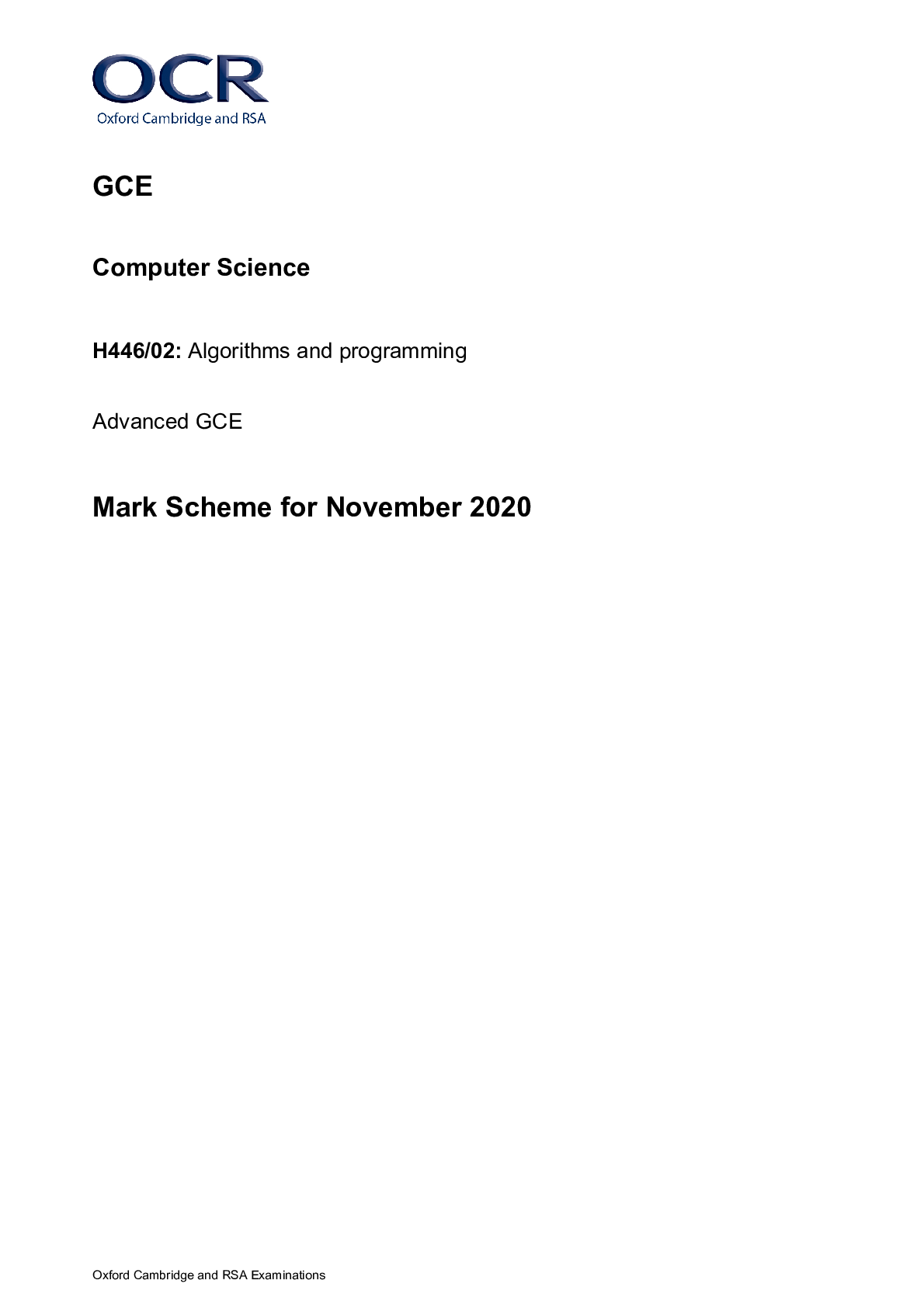
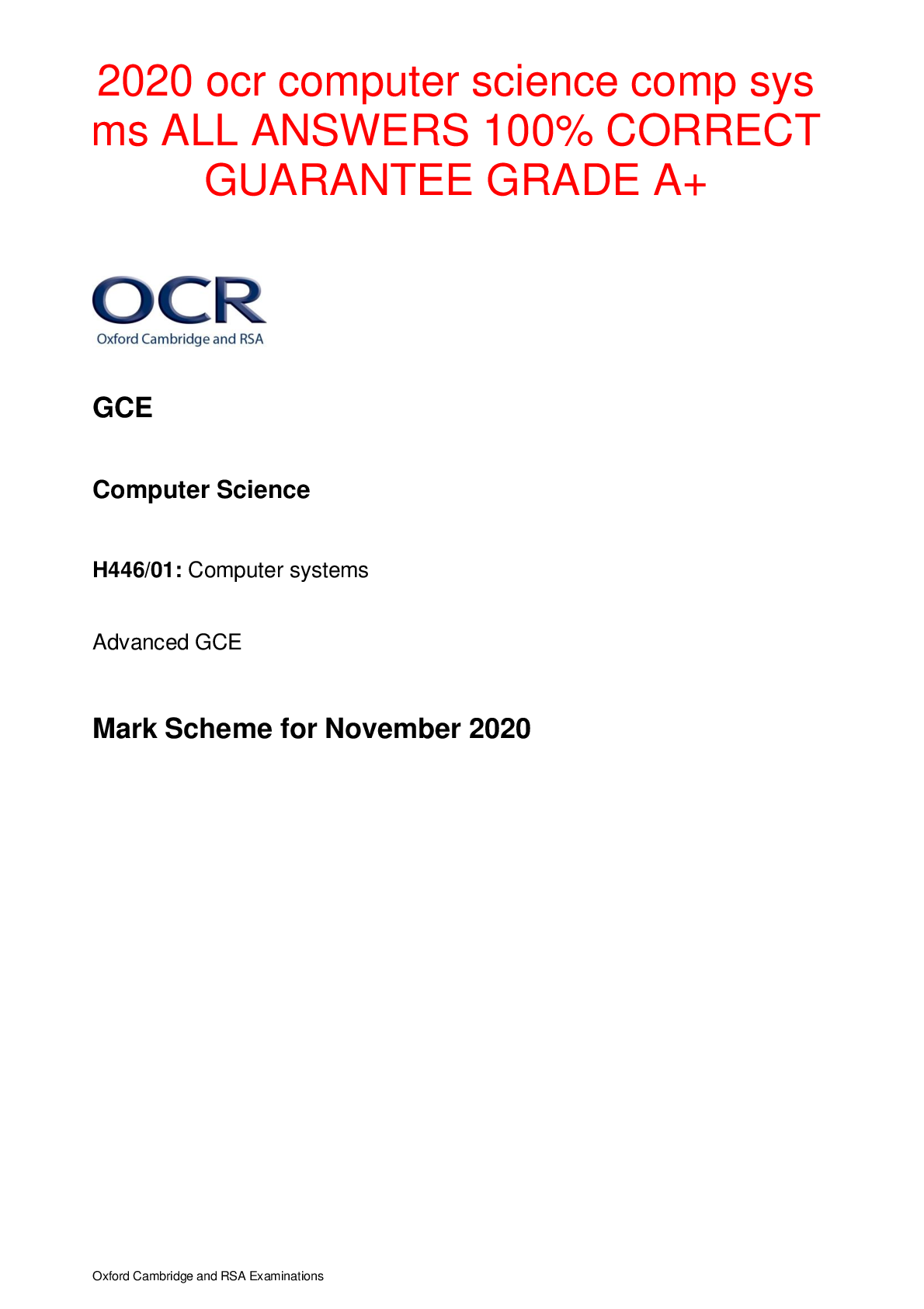
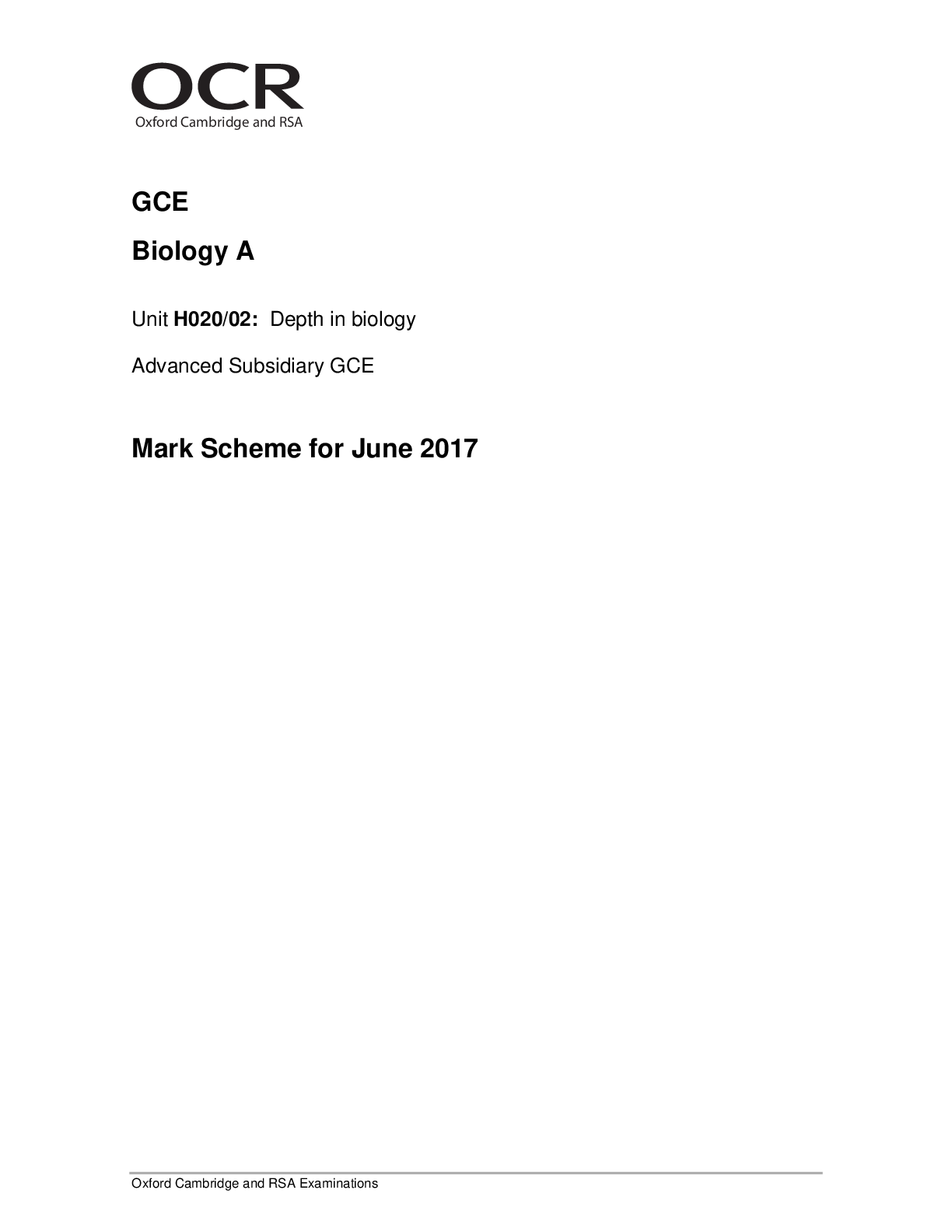


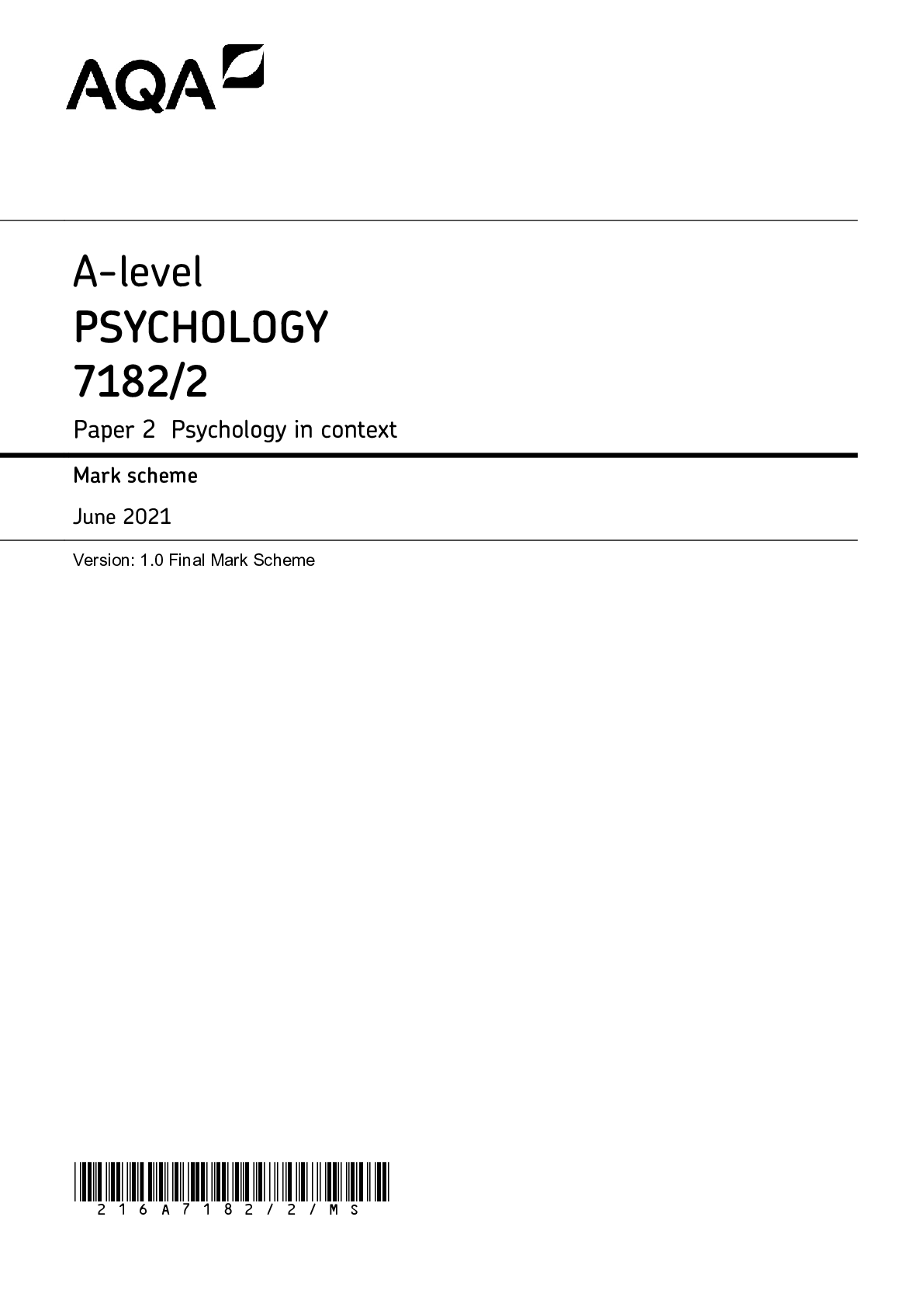
.png)


